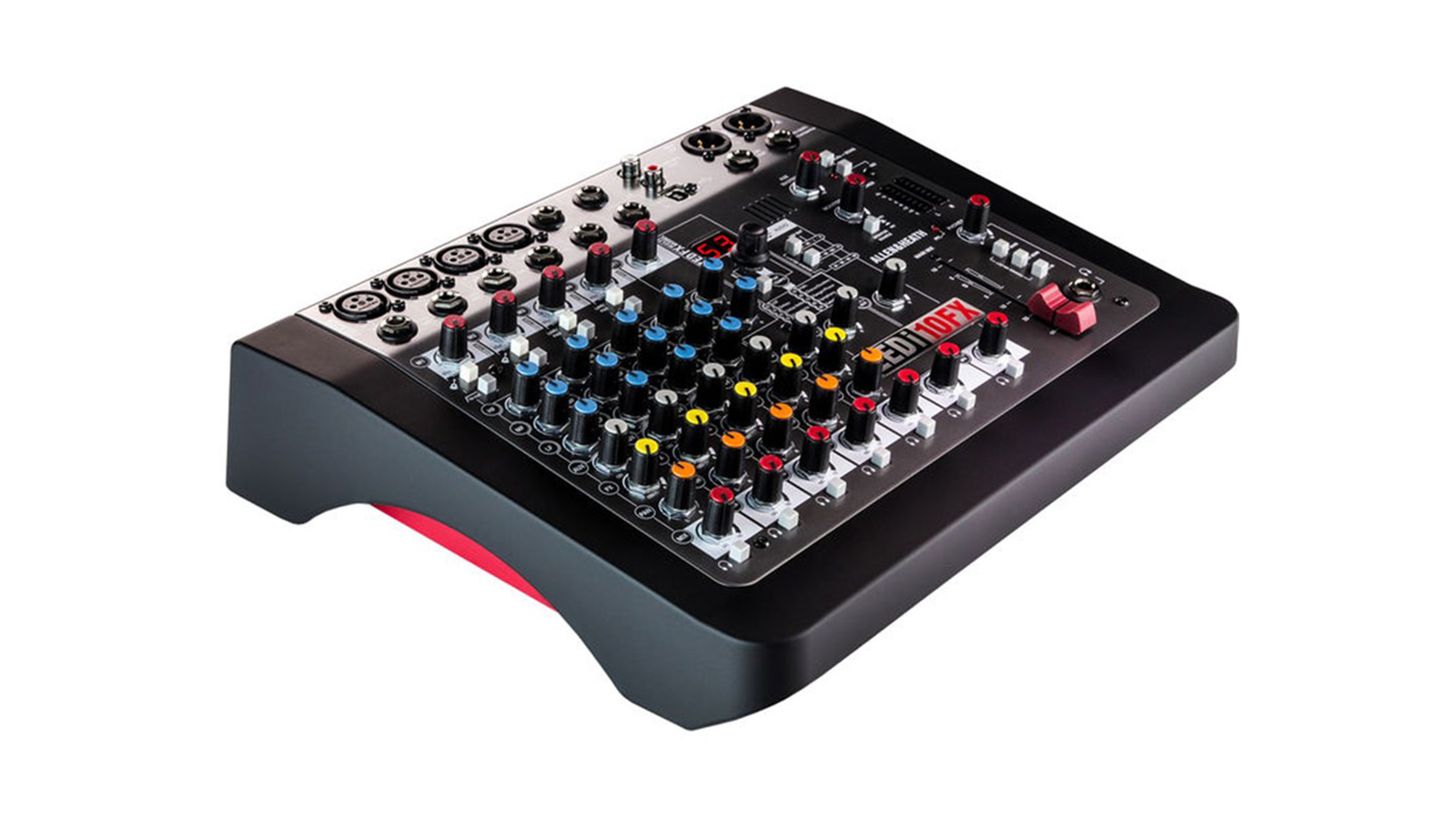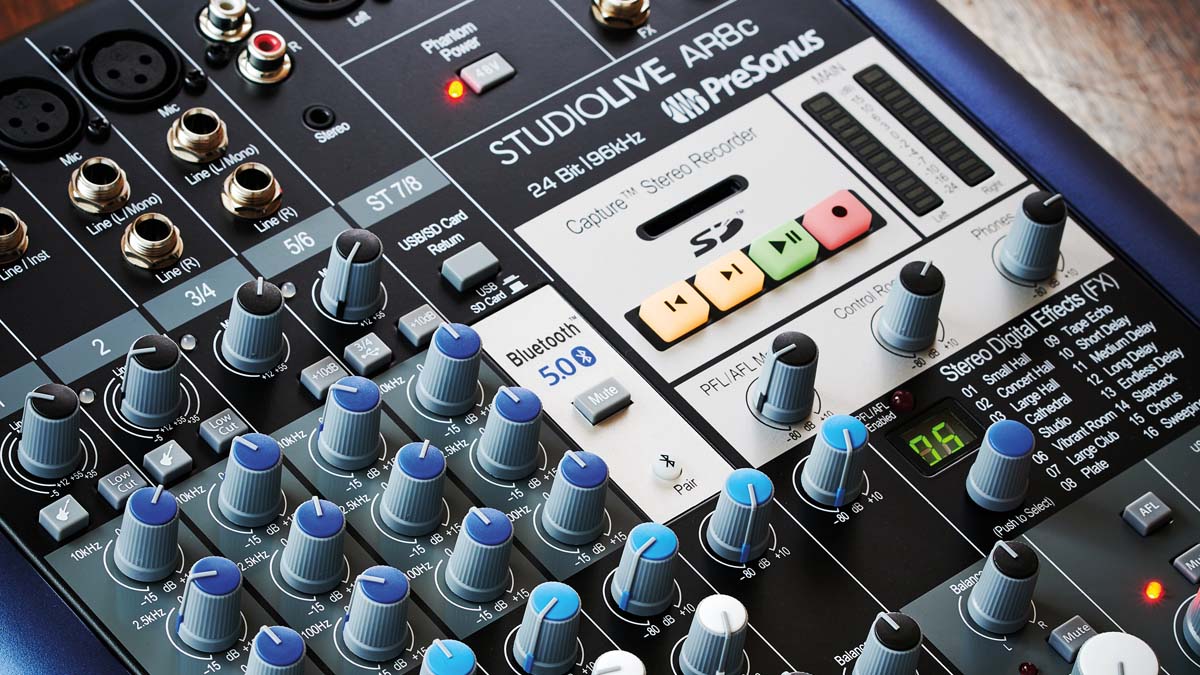MusicRadar Verdict
Despite a few compromises, the AR8c crams a lot of flexibility into a neat, well-designed mixer.
Pros
- +
Excellent mix of analogue and digital inputs.
- +
Easy-to-use onboard recorder.
- +
Sturdily built with high sound quality.
Cons
- -
No faders.
- -
Effects are nothing to write home about.
MusicRadar's got your back
The new AR8c is the smallest and most affordable entry into PreSonus’s highly-regarded line of StudioLive mixers.
Pitched as a do-it-all Pitched as a do-it-all device for small-scale live performance, studio use and podcasters, the AR8c combines an eight-track analogue mixer with a USB-C audio interface, onboard recorder and built-in effects.
On the mixer side of things, the AR8c’s first four channels are each equipped with one of Presonus’ quality XMAX high-gain preamps.
Alongside the mic inputs, channels 1 and 2 each feature a switchable mono line/instrument input, while tracks 3/4 and 5/6 feature stereo line ins. The two mono channels feature a switchable low-cut filter, while the stereo channels replace this with a +10dB input boost.
For studio users, it’s a nice solution for sampling and mixing from varied sources
Beyond this, each of these four channels is identical, featuring a three-band EQ, aux and internal effect sends, mute and pre-fader listen, pan and a level rotary.
Performance and Verdict
The use of a rotary here rather than faders is probably the most noticeable compromise the small-footprint AR8c makes compared to its larger counterparts.
Having faders to control track levels undeniably makes for a nicer experience, but the controls are well-sized and robust, so it’s a compromise most users are likely to be happy living with.
Want all the hottest music and gear news, reviews, deals, features and more, direct to your inbox? Sign up here.
As with its larger AR counterparts, the 8c’s trump card is its final, multi-functional mixer channel – channel 7/8, in this case. This combines both analogue and digital inputs, with stereo RCA and minijack inputs along with the ability to stream stereo audio from the USB connection, SD card port or wirelessly via Bluetooth.
Having this flexibility really adds to the appeal; for studio users, it’s a nice solution for sampling and mixing from varied sources, including YouTube or iOS apps. The trade-off for extra input options is that this channel lacks the EQ and internal effect send that others have.

• Allen & Heath ZEDi 10FX
Allen & Heath's ZED series of mixers are all well designed, well built, well equipped and suitable for a variety of studio, live and mobile recording duties. This is compact, portable, and great value.
• Mackie Mix12FX
Mackie's new mixer offers simple mixing options, excellent build quality and astonishing value.
On the audio interface front, the AR8c can stream each of its individual channels, plus master mix, via USB. It also allows for two stereo digital returns, which can be routed to channels 5/6 or 7/8 on the mixer.
The mixer comes complete with PreSonus Studio One Artist, Ableton Live Lite, and a suite of mostly ‘lite’ plugins from the likes of Arturia, iZotope and Brainworx. It also comes with its own audio recording application, Capture, which offers straightforward recording without the bells and whistles (or complexity) of a DAW.
Back on the hardware, the built-in recorder can capture the main stereo mix directly to SD card, which is handy for recording ideas, rehearsals or broadcasts on the go.
The final element is onboard effects. These offer 16 presets ranging from reverbs to chorus and several delay types. There’s no real customisation of these – reverb/delay times and feedback levels are fixed, and a little limited in use. Some form of onboard compression would have been a nice touch too.
The built-in recorder can capture the main stereo mix directly to SD card, which is handy for recording ideas, rehearsals or broadcasts on the go
Having individual FX and Aux outputs does make it easy to use external processors though, as well as create sub-mixes for monitoring. It’s not altogether perfect then, but if you can live without faders and tolerate the middle-of-the-road effects, there’s a lot of flexibility here in a conveniently small and affordable package.
MusicRadar verdict: Despite a few compromises, the AR8c crams a lot of flexibility into a neat, well-designed mixer.
The web says
"Despite being one of the smallest Presonus products, this unit is a bit bulky overall, although, when you weigh it up against the quality of the preamps it shouldn’t be a problem. It would probably best suit musicians, particularly in small bands, that are often playing in different locations, as well as home studio artists that want to upgrade from a simple two-channel interface"
Mixdown
Hands-on demos
Sweetwater
DcSoundOp
PreSonus
Specifications
- Type: Studio mixer
- Key Features: Eight track mixer with USB-c interface, internal SD recorder and built-in effects
- Inputs/Outputs: 4x mic in with XMAX pre, 2x mic/line in, 2x stereo line in, 1x RCA in, 1x stereo minijack in, stereo XLR master out, stereo jack control room out, FX out, aux out, phones out, footswitch in. Bluetooth equipped
- Contact: Presonus
I'm the Managing Editor of Music Technology at MusicRadar and former Editor-in-Chief of Future Music, Computer Music and Electronic Musician. I've been messing around with music tech in various forms for over two decades. I've also spent the last 10 years forgetting how to play guitar. Find me in the chillout room at raves complaining that it's past my bedtime.

